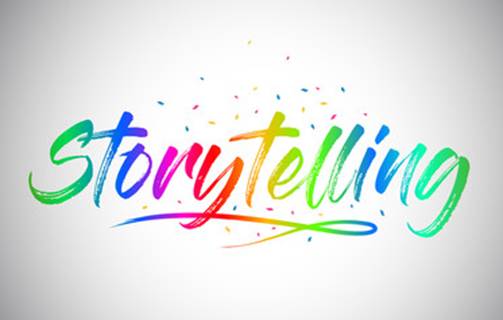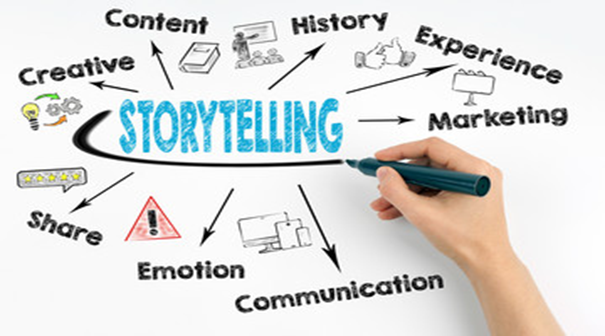5 Ways How Art of Storytelling can Improve Communication in Organization

- 18-02-2021
“The purpose of a storyteller is not to tell you how to think, but to give you questions to think upon.” - Brandon Sanderson
What is Storytelling?

Storytelling is the process of using facts and narratives to communicate something to your audience. It is the art of telling the stories. Every person has many stories of his own life. Storytelling is something we all do from our childhood days without any training. The practice of storytelling is age-old and comes from folklore.
We all love to listen and tell stories. But, there is a difference between just telling and good storytelling. A good story not only entertains but also conveys the message to motivate and ignite a fire within your audience. Storytelling is an art that requires creativity, vision, skill, and practice. It is also an important component of marketing to gain the trust of the customers. This technique is used to motivate the employees in the organizations.
Storytelling is a fact-based sensory account of events. It is an organized sequence of sensory details to form an emotional arc. It is a useful narrative technique to motivate the team at the workplace. It tells what your brand stands for. It is an emotional and engaging way to reach the emotional core of the employees.
Why do Organizations Need Storytelling?

Telling a story means painting a picture with a paintbrush of words. Stories are a universal language. Everyone understands the language of the story regardless of dialect, country, or culture. Story stimulates imagination and passion. It creates a sense of communication between the listener and the story-teller.
Story activates the function of neural coupling in the listener’s brain. This function converts the ideas presented in the stories into his or her own experiences. Storytelling generates emotions like joy, empathy, and cooperation that create reliability and a sense of willingness to work together.
Stories are heard anywhere and everywhere in the organization. People love to share the stories. It can be in the canteen, outside the toilets and bathrooms, inside or outside the boardrooms, or at the water coolers. The stories connect with the employees more easily than any other technique of communication.
Though storytelling is an ancient technique, it is widely ignored and undervalued by organizations. Unfortunately, less attention has been given to storytelling techniques. If the objective of the storytelling is set properly, the impact will be positive on the employees. It is the art that establishes a call-to-action.
The storytelling technique is useful while forming strategies for change in the organization. Employees are bombarded with much information daily in the form of presentations, bulletins, memos, discussions, emails, etc. Sometimes, information through these channels is either ignored or forgotten. The storytelling technique generates a stronger reaction as compared to passive data. Stories touch people on an experiential and emotional level. And, that’s where change occurs.
5 Ways How Art of Storytelling can Improve Communication in the Organization
1. By Sharing Vision, Mission, and Culture
The organizations need to share the vision, mission, and culture of the organization with the new employees with the help of storytelling. At the same time, organizations must share vision, mission, and culture with the existing employees at regular intervals. Animated videos of short duration will make a deep impact to communicate the culture and the values of the organization. The new hires will lead the tradition and the culture forward if they are influenced by the stories and could relate to them.
2.Training and Development Programs

Trainers can use the storytelling technique in training programs, workshops, webinars, or leadership development programs. They can share personal experiences by using frameworks and models. This will help the learners to accept the practical applications. Storytelling keeps the learners engaged and committed.
3. Employee Coaching

Coaching creates a personal connection with the learner. Coaches share their life stories with the audience. The learners develop trust in their coach. Stories can leave a deep impact on the minds of the learners and enable them to take action in the right direction. Coaching sessions encourage each employee to tell their story and empower them to rise with confidence.
4. Change Communication
Every organization has its own share of turbulences. At times the seas are rough and sometimes it’s a smooth ride. For the management to communicate good news is easy. But when the going gets tough, the tough get going. When the organization is going through a low profitable period, job cuts, layoffs, communication to the employees is crucial. In such a critical time, leaders usually select improper ways of communication. They prefer grapevine communication that causes fear and anxiety. Or they choose to remain silent and create an unnecessary mystery which could shake the employee morale. Using storytelling methods, the managers can put forth honest positions in front of the employees and urge support and cooperation. Leaders can win the trust of their subordinates and avoid anxiety and fear.
5. Leadership Communication
Leadership communication aims to influence change and negotiations with storytelling. It motivates employees, employers, and customers to create a win-win for the organization. Storytelling is a communication strategy that guides the head and heart of the listeners to meet the end-results.
How Art of Storytelling can Improve Communication in Organization
1. Storytelling Overcomes Common Blocks
Storytelling is a way of driving forward action in the organization. Employees are attuned to get stimulated by the details of people and objects. Storytelling with sensory details of objects and people grab their attention. These engagements undo the blocks. The employees are ready to get motivated.
2. Resolves Conflicts
Miscommunication leads to conflicts. As a result, conscious and unconscious emotional turbulence arises amongst employees. The storytelling method helps to resolve conflicts. It removes and breaks the barriers. Employees listen and understand each other with great empathy.
3. Helps Employees to learn Conversation Skills
The employees must be good at conversational skills to win the heart of customers. The art of storytelling helps them to create stories of success and perfection to get potential customers. Storytelling is an important strategy for marketing and branding.
4. Improves Interpersonal Rapport inside the Organization
Storytelling way of communication improves the interpersonal rapport inside the organization. They treat each other with empathy and cooperation.

The art of storytelling enables employees to think out of the box. The organizations win the trust of their workers and employees. They feel safe and entrust their organization. They get the opportunity to excavate their experiences and create strong narratives to get the desired results. They give equal value to the organization. Storytelling is not just a technique, it becomes a culture, a communication style in the organization which makes a deeper outcome on the listeners.





